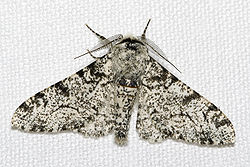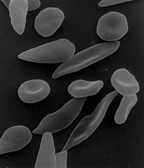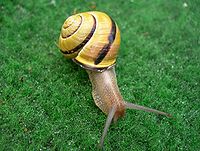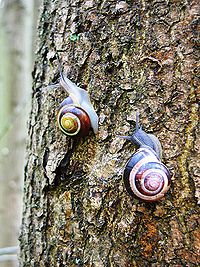
Balancing selection
Encyclopedia
Balancing selection refers to a number of selective processes
by which multiple allele
s (different versions of a gene
) are actively maintained in the gene pool
of a population
at frequencies above that of gene mutation. This usually happens when the heterozygotes for the alleles under consideration have a higher adaptive value than the homozygote. In this way genetic polymorphism
is conserved.

 There are three main types of natural selection: In directional selection
There are three main types of natural selection: In directional selection
the allele frequency
for a trait continuously shifts in one direction. In stabilizing selection
the frequency of the alleles of lower fitness decreases until they vanish. Balancing selection is similar but not identical to disruptive selection
where individuals of extreme trait values are favored against those with average trait values. These terms are used for quantitative characters
controlled by a number of genes.
Evidence for balancing selection can be found in the number of alleles in a population which are maintained above mutation rate frequencies. All modern research has shown that this significant genetic variation is ubiquitous in panmictic populations. It is a genetic expression of the field experience of Darwin
, Wallace
and others, that natural populations in the wild are extraordinarily varied (though not all such variation is of genetic origin).
There are several mechanisms (which are not exclusive within any given population) by which balancing selection works to maintain polymorphism. The two major and most studied are heterozygote advantage and frequency-dependent selection.

In heterozygote advantage
, or heterotic balancing selection, an individual who is heterozygous at a particular gene locus
has a greater fitness
than a homozygous individual. Polymorphisms maintained by this mechanism are balanced polymorphisms.
A well-studied case is that of sickle cell anemia
in humans, a hereditary
disease that damages red blood cells. Sickle cell anemia is caused by the inheritance of a variant hemoglobin
gene
(HgbS) from both parents. In these individuals, hemoglobin in red blood cells is extremely sensitive to oxygen deprivation, and this causes shorter life expectancy.
A person who inherits the sickle cell gene from one parent, and a normal hemoglobin gene (HgbA) from the other, has a normal life expectancy. However, these heterozygote individuals, known as carriers of the sickle cell trait
, may suffer problems from time to time.
The heterozygote is resistant to the malarial parasite which kills a large number of people each year. This is balancing selection between fierce selection against homozygous sickle-cell sufferers, and selection against the standard HgbA homozygotes by malaria. The heterozygote has a permanent advantage (a higher fitness) wherever malaria exists.
, rare morphs of prey are actually fitter due to predators concentrating on the more frequent morphs.
).
 In England the snail is regularly preyed upon by the Song Thrush
In England the snail is regularly preyed upon by the Song Thrush
Turdus philomelos, which breaks them open on thrush anvils (large stones). Here fragments accumulate, permitting researchers to analyse the snails taken. The thrushes hunt by sight, and capture selectively those forms which match the habitat least well. Snail colonies are found in woodland, hedgerows and grassland, and the predation determines the proportion of phenotypes (morphs) found in each colony.
 A second kind of selection also operates on the snail, whereby certain heterozygotes have a physiological advantage over the homozygotes. Thirdly, apostatic selection
A second kind of selection also operates on the snail, whereby certain heterozygotes have a physiological advantage over the homozygotes. Thirdly, apostatic selection
is likely, with the birds preferentially taking the most common morph. This is the 'search pattern' effect, where a predominantly visual predator persists in targeting the morph which gave a good result, even though other morphs are available.
The polymorphism survives in almost all habitats, though the proportions of morphs varies considerably. The alleles controlling the polymorphism form a super-gene with linkage so close as to be nearly absolute. This control saves the population from a high proportion of undesirable recombinants.
To sum up, in this species predation by birds appears to be the main (but not the only) selective force driving the polymorphism. The snails live on heterogeneous backgrounds, and thrush are adept at detecting poor matches. The inheritance of physiological and cryptic diversity is preserved also by heterozygous advantage in the super-gene. Recent work has included the effect of shell colour on thermoregulation, and a wider selection of possible genetic influences is considered by Cook.
and his co-workers collected Drosophila pseudoobscura
and D. persimilis from wild populations in California
and neighbouring states. Using Painter's
technique they studied the polytene chromosomes and discovered that all the wild populations were polymorphic for chromosomal inversions. All the flies look alike whatever inversions they carry, so this is an example of a cryptic polymorphism. Evidence accumulated to show that natural selection was responsible:
 1. Values for heterozygote inversions of the third chromosome were often much higher than they should be under the null assumption: if no advantage for any form the number of heterozygotes should conform to Ns (number in sample) = p2+2pq+q2 where 2pq is the number of heterozygotes (see Hardy-Weinberg equilibrium).
1. Values for heterozygote inversions of the third chromosome were often much higher than they should be under the null assumption: if no advantage for any form the number of heterozygotes should conform to Ns (number in sample) = p2+2pq+q2 where 2pq is the number of heterozygotes (see Hardy-Weinberg equilibrium).
2. Using a method invented by L'Heretier and Teissier, Dobzhansky bred populations in population cages, which enabled feeding, breeding and sampling whilst preventing escape. This had the benefit of eliminating migration as a possible explanation of the results. Stocks containing inversions at a known initial frequency can be maintained in controlled conditions. It was found that the various chromosome types do not fluctuate at random, as they would if selectively neutral, but adjust to certain frequencies at which they become stabilised.
3. Different proportions of chromosome morphs were found in different areas. There is, for example, a polymorph-ratio cline
in D. robusta
along an 18 miles (29 km) transect near Gatlinburg
, TN
passing from 1000 feet (304.8 m) to 4,000 feet. Also, the same areas sampled at different times of year yielded significant differences in the proportions of forms. This indicates a regular cycle of changes which adjust the population to the seasonal conditions. For these results selection is by far the most likely explanation.
4. Lastly, morphs cannot be maintained at the high levels found simply by mutation, nor is drift a possible explanation when population numbers are high.
By 1951 Dobzhansky was persuaded that the chromosome morphs were being maintained in the population by the selective advantage of the heterozygotes, as with most polymorphisms.
Natural selection
Natural selection is the nonrandom process by which biologic traits become either more or less common in a population as a function of differential reproduction of their bearers. It is a key mechanism of evolution....
by which multiple allele
Allele
An allele is one of two or more forms of a gene or a genetic locus . "Allel" is an abbreviation of allelomorph. Sometimes, different alleles can result in different observable phenotypic traits, such as different pigmentation...
s (different versions of a gene
Gene
A gene is a molecular unit of heredity of a living organism. It is a name given to some stretches of DNA and RNA that code for a type of protein or for an RNA chain that has a function in the organism. Living beings depend on genes, as they specify all proteins and functional RNA chains...
) are actively maintained in the gene pool
Gene pool
In population genetics, a gene pool is the complete set of unique alleles in a species or population.- Description :A large gene pool indicates extensive genetic diversity, which is associated with robust populations that can survive bouts of intense selection...
of a population
Population
A population is all the organisms that both belong to the same group or species and live in the same geographical area. The area that is used to define a sexual population is such that inter-breeding is possible between any pair within the area and more probable than cross-breeding with individuals...
at frequencies above that of gene mutation. This usually happens when the heterozygotes for the alleles under consideration have a higher adaptive value than the homozygote. In this way genetic polymorphism
Polymorphism (biology)
Polymorphism in biology occurs when two or more clearly different phenotypes exist in the same population of a species — in other words, the occurrence of more than one form or morph...
is conserved.


Directional selection
In population genetics, directional selection is a mode of natural selection in which a single phenotype is favored, causing the allele frequency to continuously shift in one direction...
the allele frequency
Allele frequency
Allele frequency or Gene frequency is the proportion of all copies of a gene that is made up of a particular gene variant . In other words, it is the number of copies of a particular allele divided by the number of copies of all alleles at the genetic place in a population. It can be expressed for...
for a trait continuously shifts in one direction. In stabilizing selection
Stabilizing selection
-Description:Stabilizing or ambidirectional selection, , is a type of natural selection in which genetic diversity decreases as the population stabilizes on a particular trait value. This is probably the most common mechanism of action for natural selection...
the frequency of the alleles of lower fitness decreases until they vanish. Balancing selection is similar but not identical to disruptive selection
Disruptive selection
Disruptive selection, also called diversifying selection, describes changes in population genetics in which extreme values for a trait are favored over intermediate values. In this case, the variance of the trait increases and the population is divided into two distinct groups...
where individuals of extreme trait values are favored against those with average trait values. These terms are used for quantitative characters
Quantitative genetics
Quantitative genetics is the study of continuous traits and their underlying mechanisms. It is effectively an extension of simple Mendelian inheritance in that the combined effects of one or more genes and the environments in which they are expressed give rise to continuous distributions of...
controlled by a number of genes.
Evidence for balancing selection can be found in the number of alleles in a population which are maintained above mutation rate frequencies. All modern research has shown that this significant genetic variation is ubiquitous in panmictic populations. It is a genetic expression of the field experience of Darwin
Charles Darwin
Charles Robert Darwin FRS was an English naturalist. He established that all species of life have descended over time from common ancestry, and proposed the scientific theory that this branching pattern of evolution resulted from a process that he called natural selection.He published his theory...
, Wallace
Alfred Russel Wallace
Alfred Russel Wallace, OM, FRS was a British naturalist, explorer, geographer, anthropologist and biologist...
and others, that natural populations in the wild are extraordinarily varied (though not all such variation is of genetic origin).
There are several mechanisms (which are not exclusive within any given population) by which balancing selection works to maintain polymorphism. The two major and most studied are heterozygote advantage and frequency-dependent selection.
Heterozygote advantage

In heterozygote advantage
Heterozygote advantage
A heterozygote advantage describes the case in which the heterozygote genotype has a higher relative fitness than either the homozygote dominant or homozygote recessive genotype. The specific case of heterozygote advantage is due to a single locus known as overdominance...
, or heterotic balancing selection, an individual who is heterozygous at a particular gene locus
Locus (genetics)
In the fields of genetics and genetic computation, a locus is the specific location of a gene or DNA sequence on a chromosome. A variant of the DNA sequence at a given locus is called an allele. The ordered list of loci known for a particular genome is called a genetic map...
has a greater fitness
Fitness (biology)
Fitness is a central idea in evolutionary theory. It can be defined either with respect to a genotype or to a phenotype in a given environment...
than a homozygous individual. Polymorphisms maintained by this mechanism are balanced polymorphisms.
A well-studied case is that of sickle cell anemia
Sickle-cell disease
Sickle-cell disease , or sickle-cell anaemia or drepanocytosis, is an autosomal recessive genetic blood disorder with overdominance, characterized by red blood cells that assume an abnormal, rigid, sickle shape. Sickling decreases the cells' flexibility and results in a risk of various...
in humans, a hereditary
Heredity
Heredity is the passing of traits to offspring . This is the process by which an offspring cell or organism acquires or becomes predisposed to the characteristics of its parent cell or organism. Through heredity, variations exhibited by individuals can accumulate and cause some species to evolve...
disease that damages red blood cells. Sickle cell anemia is caused by the inheritance of a variant hemoglobin
Hemoglobin
Hemoglobin is the iron-containing oxygen-transport metalloprotein in the red blood cells of all vertebrates, with the exception of the fish family Channichthyidae, as well as the tissues of some invertebrates...
gene
Gene
A gene is a molecular unit of heredity of a living organism. It is a name given to some stretches of DNA and RNA that code for a type of protein or for an RNA chain that has a function in the organism. Living beings depend on genes, as they specify all proteins and functional RNA chains...
(HgbS) from both parents. In these individuals, hemoglobin in red blood cells is extremely sensitive to oxygen deprivation, and this causes shorter life expectancy.
A person who inherits the sickle cell gene from one parent, and a normal hemoglobin gene (HgbA) from the other, has a normal life expectancy. However, these heterozygote individuals, known as carriers of the sickle cell trait
Sickle cell trait
Sickle cell trait describes a condition in which a person has one abnormal allele of the hemoglobin beta gene , but does not display the severe symptoms of sickle cell disease that occur in a person who has two copies of that allele...
, may suffer problems from time to time.
The heterozygote is resistant to the malarial parasite which kills a large number of people each year. This is balancing selection between fierce selection against homozygous sickle-cell sufferers, and selection against the standard HgbA homozygotes by malaria. The heterozygote has a permanent advantage (a higher fitness) wherever malaria exists.
Frequency-dependent selection
Frequency-dependent selection occurs when the fitness of a phenotype is dependent on its frequency relative to other phenotypes in a given population. In positive frequency-dependent selection the fitness of a phenotype increases as it becomes more common. In negative frequency-dependent selection the fitness of a phenotype increases as it becomes less common. For example in prey switchingPrey switching
Prey switching is frequency-dependent predation, where the predator preferentially consumes the most common type of prey. The phenomenon has also been described as apostatic selection, however the two terms are generally used to describe different parts of the same phenomenon. Apostatic selection...
, rare morphs of prey are actually fitter due to predators concentrating on the more frequent morphs.
Fitness varies in time and space
The fitness of a genotype may vary greatly between larval and adult stages, or between parts of a habitat range.Selection acts at different levels
The fitness of a genotype may depend on the fitness of other genotypes in the population: this covers many natural situations where the best thing to do (from the point of view of survival and reproduction) depends on what other members of the population are doing at the time.More complex examples
Species in their natural habitat are often far more complex than the typical text-book examples.Grove snail
The Grove Snail, Cepaea nemoralis, is famous for the rich polymorphism of its shell. The system is controlled by a series of multiple alleles. Unbanded is the top dominant trait, and the forms of banding are controlled by modifier genes (see epistasisEpistasis
In genetics, epistasis is the phenomenon where the effects of one gene are modified by one or several other genes, which are sometimes called modifier genes. The gene whose phenotype is expressed is called epistatic, while the phenotype altered or suppressed is called hypostatic...
).

Song Thrush
The Song Thrush is a thrush that breeds across much of Eurasia. It is also known in English dialects as throstle or mavis. It has brown upperparts and black-spotted cream or buff underparts and has three recognised subspecies...
Turdus philomelos, which breaks them open on thrush anvils (large stones). Here fragments accumulate, permitting researchers to analyse the snails taken. The thrushes hunt by sight, and capture selectively those forms which match the habitat least well. Snail colonies are found in woodland, hedgerows and grassland, and the predation determines the proportion of phenotypes (morphs) found in each colony.

Apostatic selection
Apostatic selection is frequency-dependent selection by predators, particularly in regard to prey that are different morphs of a polymorphic species that is not a mimic of another species. It is closely linked to the idea of prey switching, however the two terms are regularly used to describe...
is likely, with the birds preferentially taking the most common morph. This is the 'search pattern' effect, where a predominantly visual predator persists in targeting the morph which gave a good result, even though other morphs are available.
The polymorphism survives in almost all habitats, though the proportions of morphs varies considerably. The alleles controlling the polymorphism form a super-gene with linkage so close as to be nearly absolute. This control saves the population from a high proportion of undesirable recombinants.
To sum up, in this species predation by birds appears to be the main (but not the only) selective force driving the polymorphism. The snails live on heterogeneous backgrounds, and thrush are adept at detecting poor matches. The inheritance of physiological and cryptic diversity is preserved also by heterozygous advantage in the super-gene. Recent work has included the effect of shell colour on thermoregulation, and a wider selection of possible genetic influences is considered by Cook.
Chromosome polymorphism in Drosophila
In the 1930s Theodosius DobzhanskyTheodosius Dobzhansky
Theodosius Grygorovych Dobzhansky ForMemRS was a prominent geneticist and evolutionary biologist, and a central figure in the field of evolutionary biology for his work in shaping the unifying modern evolutionary synthesis...
and his co-workers collected Drosophila pseudoobscura
Drosophila pseudoobscura
Drosophila pseudoobscura is a species of fruit fly, used extensively in lab studies of speciation.In 2005, D. pseudoobscura was the second Drosophila species to have its genome sequenced, after the model organism Drosophila melanogaster....
and D. persimilis from wild populations in California
California
California is a state located on the West Coast of the United States. It is by far the most populous U.S. state, and the third-largest by land area...
and neighbouring states. Using Painter's
Theophilus Painter
Theophilus Shickel Painter was an American zoologist known for his work in identifying genes in fruit flies...
technique they studied the polytene chromosomes and discovered that all the wild populations were polymorphic for chromosomal inversions. All the flies look alike whatever inversions they carry, so this is an example of a cryptic polymorphism. Evidence accumulated to show that natural selection was responsible:

2. Using a method invented by L'Heretier and Teissier, Dobzhansky bred populations in population cages, which enabled feeding, breeding and sampling whilst preventing escape. This had the benefit of eliminating migration as a possible explanation of the results. Stocks containing inversions at a known initial frequency can be maintained in controlled conditions. It was found that the various chromosome types do not fluctuate at random, as they would if selectively neutral, but adjust to certain frequencies at which they become stabilised.
3. Different proportions of chromosome morphs were found in different areas. There is, for example, a polymorph-ratio cline
Cline
Cline, as spelled, is an Irish surname with historical roots in County Roscommon.People bearing the name include:* Catherine Ann Cline , American historian and author* Edward Cline , American screenwriter and director...
in D. robusta
Drosophila robusta
Drosophila robusta is a fly species in the genus Drosophila, first described by Alfred Sturtevant in 1916....
along an 18 miles (29 km) transect near Gatlinburg
Gatlinburg, Tennessee
Gatlinburg is a mountain resort city in Sevier County, Tennessee, United States. As of the 2000 U.S. Census, Gatlinburg had a population of 3,828. The city is a popular vacation resort, as it rests on the border of the Great Smoky Mountains National Park along U.S...
, TN
Tennessee
Tennessee is a U.S. state located in the Southeastern United States. It has a population of 6,346,105, making it the nation's 17th-largest state by population, and covers , making it the 36th-largest by total land area...
passing from 1000 feet (304.8 m) to 4,000 feet. Also, the same areas sampled at different times of year yielded significant differences in the proportions of forms. This indicates a regular cycle of changes which adjust the population to the seasonal conditions. For these results selection is by far the most likely explanation.
4. Lastly, morphs cannot be maintained at the high levels found simply by mutation, nor is drift a possible explanation when population numbers are high.
By 1951 Dobzhansky was persuaded that the chromosome morphs were being maintained in the population by the selective advantage of the heterozygotes, as with most polymorphisms.

